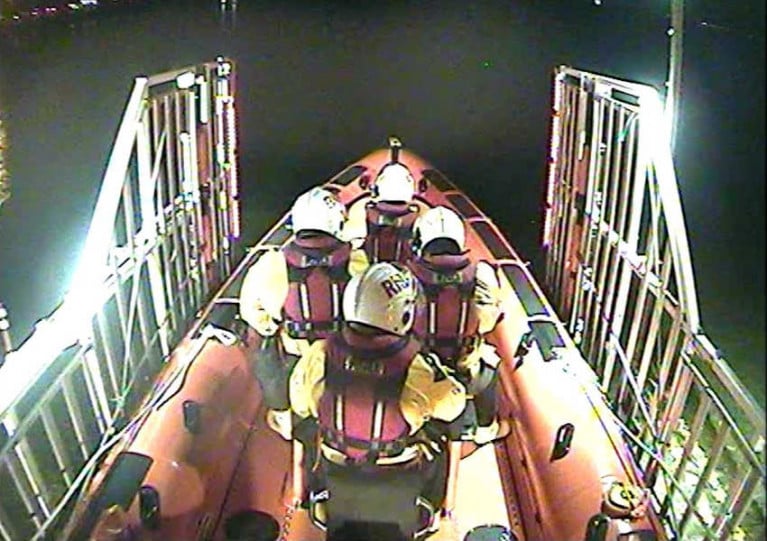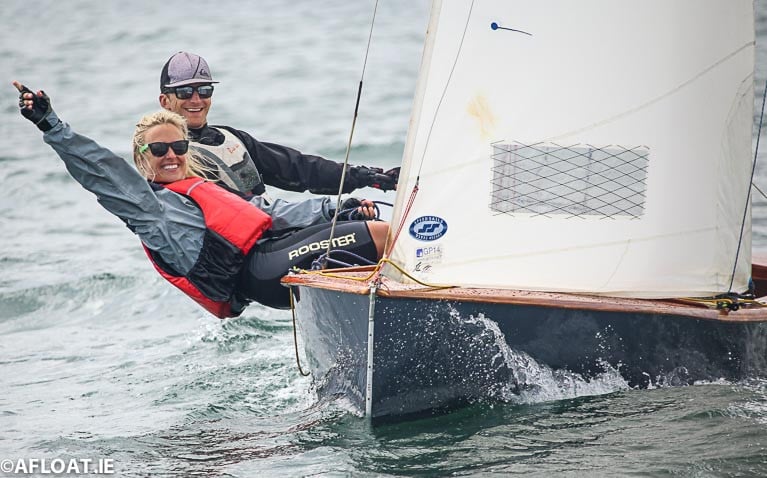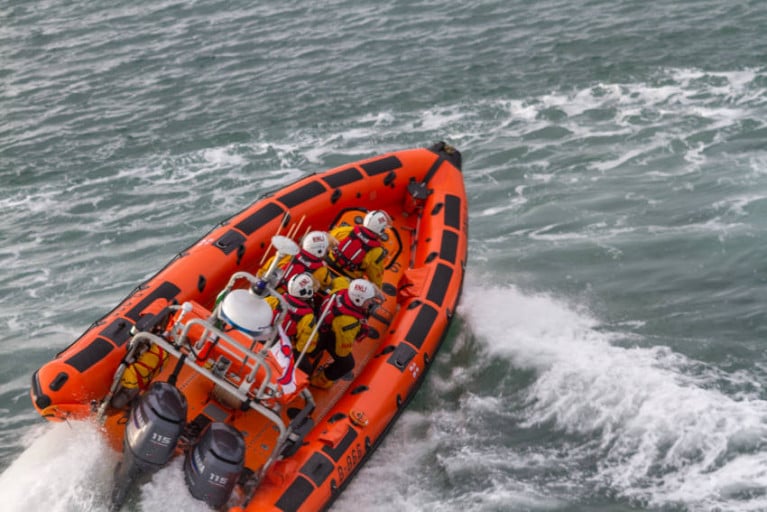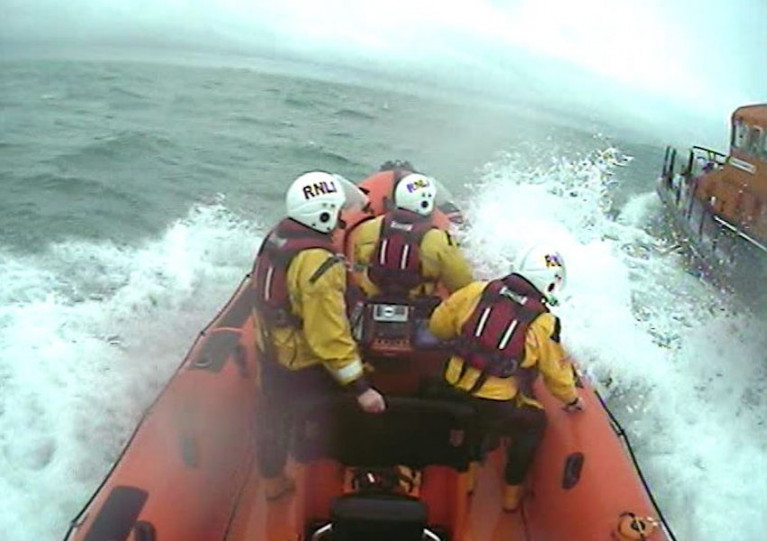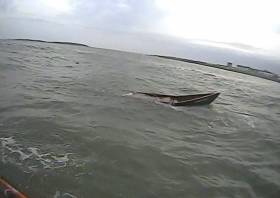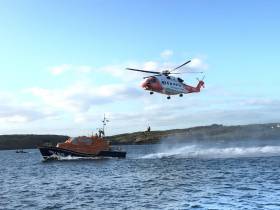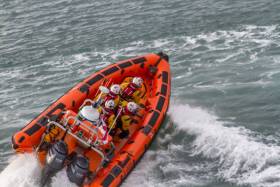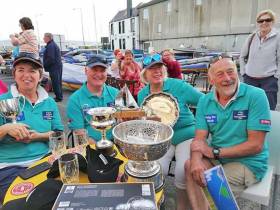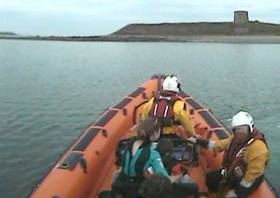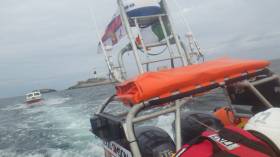Displaying items by tag: Skerries
Skerries Lifeboat Rescues Three Stranded By Tide
Skerries RNLI launched in the early hours of yesterday morning (Saturday 9 May) to a call for help from three people cut off by the tide near Balbriggan in north Co Dublin.
The Atlantic 85 inshore lifeboat Louis Simson launched shortly before 1am to the location given by the two women and one man south of Balbriggan Harbour.
Upon the lifeboat’s arrival, the trio made their way onto a rocky outcrop to stay out of the water while the RNLI volunteers determined the safest approach, illuminating the area by flare.
All three were then assisted into the lifeboat, with no first aid required.
Speaking about the callout, press officer Gerry Canning said: “Our volunteer crew remain on call 24/7 throughout the coronavirus pandemic, and they showed again tonight that they are always ready to drop whatever they are doing and respond to any call for help.”
The RNLI and Irish Coast Guard recently renewed their call for people not to use the sea for exercise or recreation as Ireland moves towards the first phase of relaxing movement restrictions amid the coronavirus pandemic.
A further update on the status of the GP14 World Championships scheduled for July in Skerries, North Dublin is expected before the end of April.
GP14 Ireland Hon. Secretary Andy Johnston has told the class the International Committee in conjunction with the Skerries GP14 Worlds Organising Committee is in 'constant communications' with regard to the running of the World Championships and the threat posed by COVID-19 to the successful staging of the event.
As Afloat previously reported, more than 100 boats have now entered for the Championships at Skerries Sailing Club from July 24-29.
Johnston also advises the sailors that 'it is with regret but no surprise' that the Munsters at Cullaun Sailing Club and the Leinsters at (Mullingar Sailing Club) ear-marked for the weekends of May 2/3 and May 23/24 respectively have been postponed.
Depending on the COVID-19 situation, the Clubs would hope that one or both may be run at a later date this summer.
With travel restrictions in place across Ireland and the UK, all GP14 coaching dates have also been cancelled.
Skerries RNLI launched yesterday afternoon (Wednesday 4 March) after Dublin Coast Guard made them aware of a swimmer in difficulty at Red Island headland in Skerries.
The volunteer crew launched the Atlantic 85 lifeboat shortly after 12pm and proceeded to the area that the swimmer was reported to be in (see video HERE).
Arriving on scene, the lifeboat discovered that swimmer had made their way ashore on the rock and the winchman/paramedic from the Irish Coast Guard helicopter Rescue 116 had already reached them.
Two volunteer crew were put ashore to see if they could offer any assistance to the coastguard. The swimmer was uninjured, however the low tide at the time meant that walking across the sharp rocks was not possible in bare foot.
The decision was taken to winch them aboard the helicopter before landing on Red Island where local coastguard volunteers had set up and secured a landing area. The casualty was then transferred to an ambulance to be assessed.
The crew returned to the lifeboat and they stood by while the winch operation was carried out before standing down and returning to the station.
Speaking about the callout, volunteer lifeboat press officer Gerry Canning said: “The swimmer made the right call to head for shore and look for assistance as soon as possible. This was a good outcome today and it’s always great to see how well the different rescue services work together.”
The incident came nine days after Skerries RNLI’s first callout of the year, responding to the activation of an emergency beacon at sea.
First Callout Of 2020 For Skerries Lifeboat In Launch To Emergency Beacon
The first time this year that pagers sounded for the volunteers of Skerries RNLI may have ended in a false alarm.
But the crew of the North Co Dublin lifeboat station confirms it takes any activation of an emergency beacon seriously.
Skerries RNLI were tasked shortly before 7.30am yesterday morning (Monday 24 February) after Dublin Coast Guard picked up the signal from an emergency beacon almost two miles north-east of Skerries.
The Atlantic 85 inshore lifeboat was launched by the volunteer crew into strong west to south-west winds, gusting to 30 knots at times.
Skerries lifeboat, the Howth lifeboat and the Irish Coast Guard’s helicopter Rescue 116 all proceeded to the last co-ordinates received and began a thorough search of the area in challenging conditions.
It was soon found that the vessel registered to the EPIRB (emergency position-indicating radio beacon) was safely tied up in Skerries Harbour, but the EPIRB had been removed.
The lifeboats and the helicopter continued to search the area until the coastguard was satisfied that the beacon had not been taken to sea aboard another vessel, and the operation was stood down.
Speaking about the callout, volunteer lifeboat press officer for Skerries RNLI, Gerry Canning, said: “EPIRBs are a vital piece of safety equipment, often designed to activate when a vessel capsizes or sinks, so any activation has to be treated very seriously.
“It was a wet morning for most people today, but even more so for our crews.”
Skerries Lifeboat Tasked To Capsized Currach
Skerries RNLI launched to the rescue of a man and two teenagers in the water after their currach capsized off the north Co Dublin town yesterday evening (Saturday 21 September).
Just after 5pm, Dublin Coast Guard picked up a Mayday transmission from the 14ft currach. Skerries RNLI says that at first the location was unclear.
But several 999 calls from concerned onlookers confirmed that it was near the port lateral marker, known locally as the Perch Mark, just off the headland in Skerries.
The volunteer RNLI crew launched their Atlantic 85 inshore lifeboat Louis Simson to the stricken vessel, which could be seen from the lifeboat station.
Arriving on scene at the same time as the Irish Coast Guard helicopter Rescue 116, the crew learned that Skerries Sailing Club’s tender had also picked up the Mayday and, together with another local angling boat, had taken the man and teenagers from the water.
The casualties were then transferred to the lifeboat and brought ashore and to dry off and warm up. Dublin Fire Brigade paramedics attended to give first aid before a HSE ambulance arrived and gave the trio a full checkover.
Meanwhile, Skerries RNLI reports that the capsized currach was returned to the beach and the oars and other items lost overboard were recovered.
“Accidents can happen at sea at any time,” said Skerries RNLI press officer Gerry Canning. “Everyone on board was wearing a lifejacket, and they had a waterproof VHF to raise the alarm, which is really encouraging to see.
“This was a great team effort across multiple different emergency services with everyone playing their part. We’d also like to commend the young man driving the boat for Skerries Sailing Club and the local angling boat for their swift actions.”
A motorboat that became propped up on pot buoys in Baltimore Harbour at the weekend made a direct call for help to the local RNLI’s all-weather lifeboat which was returning to base nearby.
The incident occurred on Saturday evening (7 September) after the Baltimore lifeboat had just completed a training exercise with the Irish Coast Guard’s Waterford-based helicopter Rescue 117.
Lifeboat press officer Kate Callanan said: “The skipper of the motorboat realised immediately that he needed assistance and as he had been watching the lifeboat and helicopter demonstration minutes before, he knew that the quickest way to alert the lifeboat was to call them directly on channel 16 on his VHF.”
Within minutes the all-weather lifeboat — with coxswain Kieran Cotter, mechanic Cathal Cottrell and crew members Emma Lupton, Ronnie Carthy, David Ryan, Jim Griffiths, Ryan O’Mahony and Eoin Ryan — was alongside the 33ft motor vessel.
Another motorboat skippered by former lifeboat crewman Torsten Marten was also nearby at the time, and he was drafted to assist in transferring two lifeboat crew to the casualty vessel rather than having to launch the lifeboat’s Y-boat.
The casualty boat was then secured alongside the all-weather lifeboat and brought to the safety of Baltimore’s North Pier.
Callanan reminded all boaters: “It is vital for anyone going to sea to always carry a means of communication such as a mobile phone or VHF in order to raise the alarm should they require help.”
The callout came on the eve of Baltimore RNLI’s centenary celebration yesterday (Sunday 8 September), at which it named its new Atlantic 85 inshore vessel 100 years to the date since the arrival of its first ever lifeboat.
Elsewhere, Skerries RNLI launched on Thursday night (5 September) to tow a razor fishing boat with two on board that struck rocks off Red Island and damaged its steering.
Skerries RNLI volunteers responded to three callouts in less than a week starting last Friday (19 July) when they towed a small fishing boat to safety.
They were called out again on Monday to assist three teenagers on an inflatable dinghy, and on Wednesday to investigate a kite surfer in distress.
Shortly before 2pm last Friday afternoon (19 July), one of the Skerries RNLI volunteer crew spotted a small fishing boat that appeared to be drifting quite close to the shoreline.
The volunteer crew launched their Atlantic 85 inshore lifeboat Louis Simson and made their way out to the fishing boat.
There was one man on board and he confirmed that the boat had suffered engine failure. A tow was established and the boat was towed safely into Skerries Harbour.
On Monday evening (22 July), just after 6pm, Skerries RNLI were tasked after Dublin Coast Guard received a call expressing concern for three teenagers in an inflatable dinghy who were drifting off the headland at Red Island.
Just as the crew reached the station, the lifeboat was stood down as the teenagers had managed to make it back to shore.
The pagers sounded once again on Wednesday evening (24 July) at 6.30pm after what appeared to be a kite belonging to a kitesurfer was spotted, semi-submerged, south of Shenick Island off Skerries.
The lifeboat was launched and proceeded directly to the area indicated by the caller. A search of the area was carried out and the object was spotted on the shore of the island.
A crew member entered the water and swam ashore to investigate the object, which turned out to be a discarded tent.
With the crew member safely back on board the lifeboat, the helm updated Dublin Coast Guard and the lifeboat was stood down.
Speaking about the busy week, volunteer lifeboat press officer Gerry Canning said: “With the great weather we’ve been having here has been an increase in callouts all around the coast, particularly involving inflatables.
“We all love to enjoy the water, but we’d advise people to check out the RNLI and Water Safety Ireland websites (RNLI.org and WaterSafety.ie) for tips on how to enjoy yourself while staying safe at the beach.”
Triumph For Skerries At 2019 E-Boat Nationals In Clontarf
With the passing of the Summer Solstice, it was time again to focus one’s gaze from celestial to nautical observations, in particular the E-Boat National Championships of 2019 hosted over the weekend of 6-7 July by Clontarf Yacht & Boat Club, writes Findlay MacDonald.
Ian Sargent was this year’s Principal Race Officer. He made use of the very light conditions, wisely choosing to set two days of sailing within the confines of Dublin Port. Setting courses on the open sea and strong tide would have hampered and delayed racing and would not have allowed a full six races to be run.
Nevertheless, in near perfect ‘lake conditions’, excellent courses were set each day providing lively competition for all — testing both tactics and boat-handling of all competitors.
This year’s Nationals saw a good turnout of six local boats and three very warmly welcomed boats from the Skerries Sailing Club fleet, which sailed down to Howth the evening before and headed straight to the start line on Saturday morning (Eaglet, due to engine trouble, unfortunately missed the first race).
Last year’s champion Pat O’Neil and OctopussE were not present, with him being heavily engaged in campaigning his J80 and preparing for their World Championships in Spain (though missed, we wish him well in his endeavours and await his return to the fleet). With several boats in ascendancy in both fleets, odds were even across four to five boats on who might lift this year’s crown.
Steady light airs (5-7 knots) were generally from the East for the weekend, meaning ‘clean air’ was the most important criteria. Skerries’ Easy Go in Race 1 and 2 (windward returns) sped off the start line in good air avoiding congestion at the committee boat. Enchantress, and Eagle Eye (CY&BC) who showed good form in club racing this season, followed but failed to catch Easy Go who claimed the first 2 races.
The battle for second and third was very open
Race 3 saw a change in course layout from an Offset to an Olympic. Wylie Coyote finished with a commanding lead in a hotly contested race where positions from first to fourth fluctuated on each leg. Eaglet finished second, and Easy Go scored third to finish the day with a clear points lead. The battle for second and third was very open.
On Day 2, the race officer took full advantage of the space within the entire harbour, setting excellent Olympic courses. The second leg, a run down close to Bull Island promenade, made a perfect grandstand for onshore spectators and Sunday strollers.
Again, conditions were light but constant, requiring only slight course alterations between races which were run efficiently and promptly, and started with little bias in the start line.
Race 4 saw Enchantress executing a perfect race, leading with pace from the line to the finish, tactically controlling the race from the front. In Race 5, Enchantress, on port, found themselves rolled at the top mark as they were closed out of the lay-line as the fleet came around closely packed together. Good boat handling saw Enchantress come back to third. The race went to Easy Go who now had a commanding lead in the series. Skerries’ Eaglet again showed strong form and saw off competition to finish second in the race.
For the last race of the day, winds were waning but still a fiercely contested race was had. Local boats Euro and Wylie contested valiantly but were no match for Easy Go and Eaglet. Easy Go looked good for a fourth bullet at the last mark rounding, but Eaglet had the speed on the sprint to the line and claimed a deserved first. Euro, having been in the running for the race, just didn't quite have enough juice in the engine and finished the day only yards behind second.
Wylie Coyote and Eagle Eye in the last 100 yards looked good for claiming fourth but were beaten by the beautiful E-Type who came up the last beat at speed on a fresh breeze after rounding the last mark in seventh.
With many boats sporting fresh crew, it was good to see a mix of results and closeness in the racing
In 15 years of competing in the E Boat Nationals, this year’s deserved National Champion was Paul Hick and his seasoned team on Easy Go. A strong performance and result that was a long time coming, it was great to see them succeed having missed out previously by only a few points. Enchantress (skipper Findlay MacDonald) and Eaglet (skipper Bernie Grogan) were this year’s runners-up.
With many boats sporting fresh crew, it was good to see a mix of results across the championship and closeness in the racing. There is great potential in the fleet and next year’s championship will again be hotly contested as crews refine and boats improve. Thanks goes to the hosts at CY&BC, and all crews for enthusiasm and camaraderie for making e-boats a fun and lively class.
The E-Boat Class comprises classic IOR Mini-Tonner light displacement racing yachts, designed by Julian Everett — designer of many an elegant yacht. They are a competitive one-design, rate well in IRC and have won the ICRA National Championships. Fleets in Skerries and Clontarf remain active and engaged and are always welcoming of new boats and skippers.
Skerries RNLI helped rescue a woman and two children yesterday afternoon (Wednesday 10 July) after they were stranded on Shenick Island having been cut off by the rising tide.
Shortly after 3pm, the Irish Coast Guard tasked the north Co Dublin lifeboat station to investigate reports of a person waving for help on Shenick Island off Skerries.
The volunteer crew launched their Atlantic 85 inshore lifeboat Louis Simson and rounded the headland at Red Island before proceeding to Shenick, where they found that lifeguards from the South Beach had reached the island in their dinghy and were checking on the woman and children’s wellbeing.
The three had walked to the island and had been cut off by the rising tide. They mentioned that they were beginning to feel cold so the crew transferred them to the lifeboat and returned to the station to warm up before a volunteer crew member drove them home.
Speaking about the callout, volunteer press officer Gerry Canning said: “It can be tempting to walk out to Shenick Island when the tide is low enough. However, the window for the tide is quite short and the island is bigger than it looks.
“We’d remind anyone walking along the coast to check the tide times and be aware of the risk of getting cut off. Always tell someone where you are going and ensure you have a means of contacting the shore.”
Skerries RNLI towed two adults and two teenagers to safety on Saturday afternoon (25 May) after their motorboat broke down east of Rockabill Lighthouse.
Shortly after 5.30pm, Skerries RNLI were tasked by Dublin Coast Guard to assist a 21ft motorboat that had suffered engine failure off the lighthouse.
Visibility was good and conditions were calm, with a Force 2 north-westerly wind, as the volunteer crew launched their Atlantic 85 inshore lifeboat Louis Simson to the location.
A tow was quickly established and the casualty boat was brought safely back to the slipway in Skerries. All on board were wearing lifejackets.
Speaking about the callout, volunteer lifeboat press officer Gerry Canning said: “We’ve had a number of calls recently where engine failure has been the cause. However it’s encouraging to see all on board wearing lifejackets once again.
“Lifejackets save lives and the message seems to be getting across.”



























